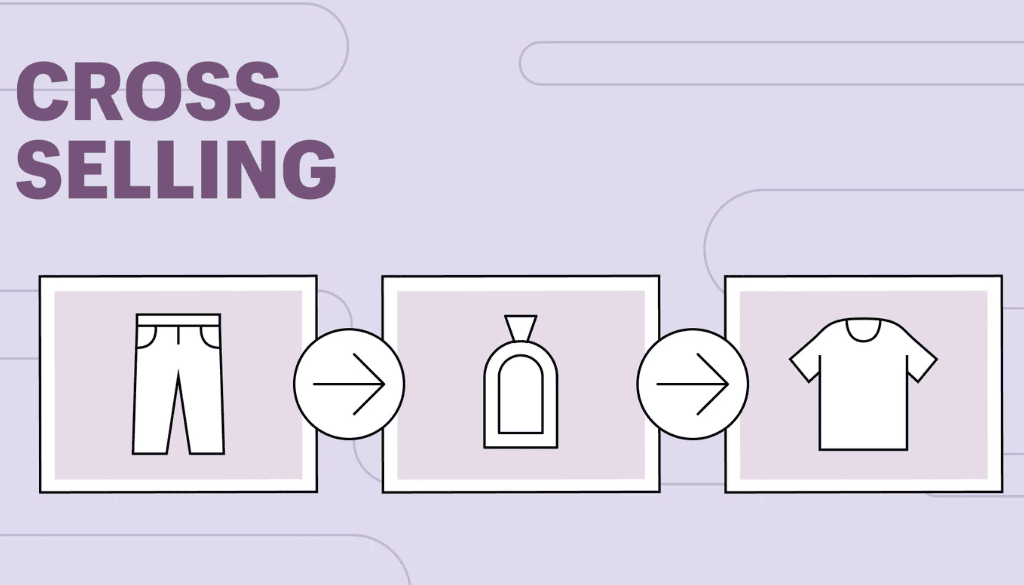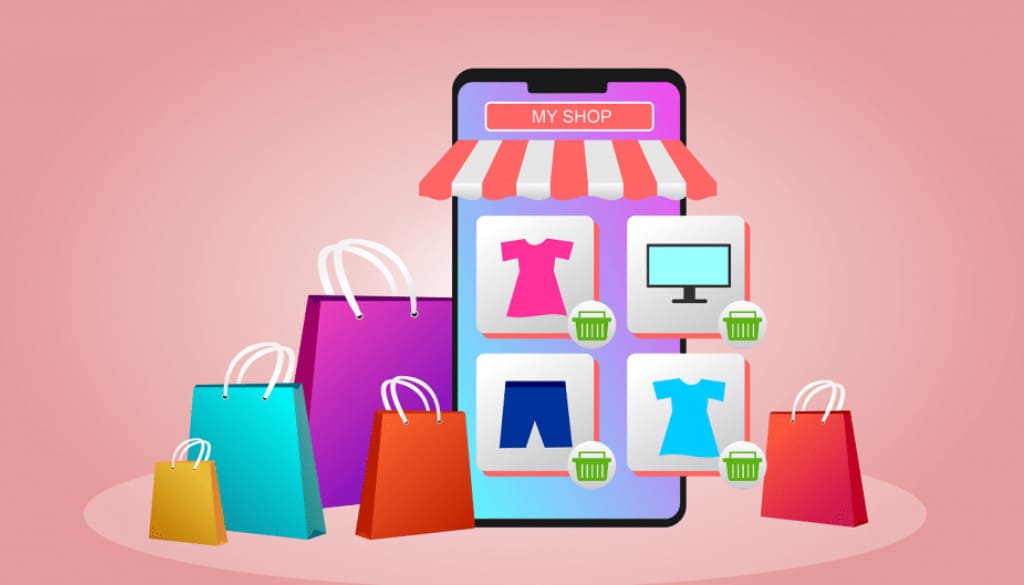In today’s increasingly competitive e-commerce landscape, maximizing the value of every order is crucial for sustainable growth. For the Print on Demand (POD) business model, Cross Selling is not just a strategy to increase revenue – it’s a powerful tool to enhance customer experience and optimize your product catalog. This article will help you understand: What is Cross Selling?, why it matters in POD, and how to apply it effectively in practice.
What is Cross Selling?

At its core, Cross Sell (also known as cross-selling) is a sales technique used to encourage customers to purchase additional, complementary products or services related to the item they have already bought or are planning to buy.
Unlike Upselling – which offers an upgraded or more expensive version of the same product – Cross Selling focuses on increasing the total order value by suggesting compatible, add-on items based on the customer’s broader needs or preferences.
A typical example in POD:
If a customer buys a t-shirt with a pet illustration, you can suggest a matching mug, hat, or tote bag featuring the same theme. This not only boosts revenue but also creates a more personalized shopping experience.
Key Differences Between Cross Selling and Upselling:
- Upselling: Persuade the customer to purchase a higher-end or more premium version of the same product.
Example: Offering an organic cotton t-shirt instead of a regular cotton one. - Cross Selling: Suggest additional, related products that complement the main item.
Example: When a customer buys a t-shirt, recommend a hat or tote bag with the same design.
Benefits of Cross Selling in the POD Model
Cross Selling is more than just a sales tactic – it’s a powerful tool for delivering a personalized shopping experience and driving long-term business growth. Here are the key benefits for Print-on-Demand sellers:
1. Increase Average Order Value (AOV)
One of the most immediate advantages of implementing Cross Selling is boosting the Average Order Value (AOV). In the POD model, customers are often attracted to a product through a specific design – for example, a holiday-themed t-shirt. When sellers suggest additional products such as mugs, tote bags, caps, or stickers featuring the same concept, the chances of customers spending more increase significantly.
Example: A customer who plans to purchase a $15 t-shirt may easily be convinced to add a matching mug for $10. The total order value increases to $25 – without any extra advertising cost. This directly improves your AOV, a critical metric for evaluating your store’s profitability.
2. Optimize Advertising Costs
Customer acquisition costs (CAC) in e-commerce are climbing rapidly, especially on competitive platforms like Facebook, TikTok, and Google. With Cross Selling, you don’t need to spend more to attract new buyers – instead, you maximize the value of existing customers.
By doing so, you reduce your cost per order, increase profit margins, and improve your return on ad spend (ROAS). For POD sellers, where margins are sensitive to operational and ad costs, this benefit is particularly valuable.
3. Boost Cart Conversion Rate
A major psychological factor in purchasing decisions is the feeling of being understood. When customers see relevant product suggestions, it creates a sense of personalization and care, which increases the likelihood of completing the purchase instead of abandoning the cart.
Smart Cross Selling strategies – especially when paired with bundle discounts or time-limited offers – also create a mild sense of urgency, helping improve conversion rates naturally and effectively.
4. Improve Shopping Experience and Encourage Repeat Purchases
Cross Selling enhances the buyer journey by offering convenient, curated product combinations. Instead of having to search for matching items, customers receive ready-made suggestions that save time and effort.
Example: A customer buying a Halloween hoodie sees matching tote bags or socks recommended right in the cart. The visual and thematic consistency makes the shopping experience more enjoyable and personalized. This, in turn, increases the chances of repeat purchases and helps build customer loyalty over time.
5. Maximize Design Resources and Scale Product Lines Faster
In POD, the ability to reuse a single design across multiple product types (t-shirts, mugs, tote bags, posters, etc.) is a significant advantage. Rather than limiting a design to just one SKU, you can expand its use across your catalog and apply Cross Selling to distribute those related items.
This not only saves design time and resources, but also improves creative workflow efficiency. It’s an excellent way to scale your product offerings quickly without significantly increasing the workload.

Real-World Examples of Cross Selling in POD
To implement Cross Selling effectively in the Print on Demand (POD) model, it’s essential to understand how to apply it in specific, practical scenarios. Below are several real-world examples that demonstrate how POD sellers can use cross-selling strategies to optimize revenue, increase average order value, and enhance the overall customer shopping experience.
Example 1: Create Coordinated Product Bundles by Theme
One of the most common approaches to Cross Selling in POD is building product collections with consistent design themes.
For instance, if a customer buys a t-shirt with a pug illustration – a popular niche in the POD space – you can suggest additional items like ceramic mugs, tote bags, keychains, or hats featuring the same pug design. This creates a more personalized shopping experience and increases total revenue without requiring extra effort in creating new designs.
Example 2: Suggest Seasonal or Holiday-Themed Products
Timing is crucial in the POD business. During major holidays like Christmas, Thanksgiving, Halloween, or Valentine’s Day, themed shopping demand spikes.
If a customer buys a hoodie printed with a Christmas tree design, you can recommend complementary decorative items such as holiday socks, fleece blankets, or throw pillows with matching graphics. These items not only complete the customer’s seasonal aesthetic but also feel naturally relevant. Cross selling based on seasonal needs rarely feels intrusive because it aligns with the customer’s existing intent.
Example 3: Cross Selling During the Checkout Process
The checkout page is an ideal moment to implement Cross Selling, as the customer has already made a purchase decision and is more likely to accept additional suggestions.
For example, you can include a “You may also like” or “Add for a special price” section that displays matching products such as mugs, tote bags, or stickers featuring the same design.
Even a small discount – such as 10% off for add-ons – can significantly boost both the conversion rate and the total order value, without disrupting the customer experience.
Example 4: Post-Purchase Cross Selling via Email Marketing
Not all cross-sell opportunities happen during the initial transaction. Another effective strategy is using email marketing to recommend additional products after the customer has completed their order.
For example, if a customer purchased a t-shirt with a teacher appreciation theme, you can send an email a few days later with a message like:
“You’ve got your favorite teacher tee – now check out the matching mug and cap to complete your personalized style!”
Post-purchase cross-selling not only drives extra revenue but also keeps you connected with existing customers, increases the chances of repeat purchases, and builds long-term loyalty.
Effective Cross Selling Strategies for POD Sellers

Implementing Cross Selling successfully requires a combination of smart business strategy, an understanding of customer behavior, and the right technical tools. Below are several proven strategies POD sellers should consider:
1. Build Coordinated Product Sets by Theme
One of the simplest and most sustainable ways to apply Cross Selling in POD is by designing and categorizing products into themed collections. Popular POD themes – such as pets, professions, family, travel, zodiac signs, or holidays (Valentine’s Day, Halloween, Christmas…) – can be developed into full product sets that include t-shirts, hoodies, mugs, tote bags, stickers, hats, and more.
When a customer selects a product within a specific theme, your website or platform can automatically suggest related products in the same collection.
For example, someone who purchases a “Best Cat Dad Ever” t-shirt could be recommended a matching mug and tote bag. This strategy not only boosts additional purchases but also creates a sense of cohesion, professionalism, and personalization in the customer’s experience.
2. Use Cross Selling Software or Plugins
For sellers operating on platforms like Shopify, WooCommerce, or Etsy, many tools and plugins are available to automate Cross Selling, saving time and increasing efficiency:
- Frequently Bought Together: Displays real purchase-based product pairings.
- ReConvert Upsell & Cross Selling: Builds customizable post-purchase funnels.
- Personalizer AI Recommendation: Uses customer behavior and purchase history to provide real-time smart suggestions.
These tools monitor individual shopper behavior and show relevant recommendations – the right products, at the right moment. If implemented correctly, Cross Selling conversion rates can be 2–3 times higher than standard product listings.
3. Design a Cross Selling-Friendly Interface
The layout of your product and cart pages plays a major role in whether customers engage with Cross Selling offers. Make sure your site features prominent, non-intrusive sections like “Related Products,” “Frequently Bought Together,” or “You Might Also Like,” ideally placed:
- Below the main product description
- Near the “Add to Cart” button
- Inside the cart before checkout
However, avoid overwhelming users with too many suggestions, which can lead to distraction and reduce user experience quality.
4. Run Retargeting Ads with Cross Selling
If you already have existing customers, use retargeting ads to promote related products in the same design or theme. Leverage Facebook Pixel, TikTok Pixel, or Google Ads to build a custom audience based on past purchases and show them highly relevant items.
Example: A customer who bought a “Cat Dad” t-shirt could be retargeted with ads featuring a matching mug that says “Cat Mug – Made for Cat Lovers”, or a cute cat-themed cap. Retargeting lets you reconnect with past buyers efficiently, increasing revenue without needing to find new traffic.
5. Offer Bundled Deals to Encourage Cross Selling Behavior
Discounts and promotions are powerful motivators for increasing cart value. Create bundled offers that make it easy for customers to say yes to additional purchases. Popular formats include:
- Buy 2 products in the same design – Get 10% off.
- Add a mug for just $4.99 when buying any T-shirt.
- Free exclusive sticker when purchasing a 3-item combo.
These strategies not only increase AOV but also help you promote underperforming products or move seasonal inventory. Pro tip: Add urgency with limited-time or limited-quantity offers to drive faster action.
Key Considerations When Implementing Cross Selling
Cross Selling can deliver significant revenue growth in the POD business model. However, if implemented incorrectly, this strategy can backfire – causing customer frustration and lowering conversion rates. Below are critical insights every POD seller should keep in mind to apply Cross Selling in a thoughtful, strategic, and customer-friendly way.

1. Don’t Overwhelm Customers with Too Many Suggestions
One of the most common mistakes is displaying too many product recommendations on a single page. Instead of showing 8–10 unrelated items, focus on suggesting 2 to 4 highly relevant products. This keeps the experience clean and helps customers focus on the core purchase decision without distraction.
2. Prioritize Relevance and Personalization
Effective Cross Selling starts with a deep understanding of your customer’s intent. Ensure that the suggested products are directly related to what the customer is viewing or has already purchased.
For example, don’t recommend a soccer jersey to someone buying a pet-themed shirt – unless you have a very targeted reason for doing so. Relevance builds trust and increases the likelihood of conversion.
3. Avoid Disrupting the Shopping Experience
Cross Selling elements should be placed strategically – visible enough to catch attention, but not intrusive or interfering with key actions like “Buy Now” or “Add to Cart.”
Also, be mindful of page load speeds and layout clarity. A cluttered interface can cause users to leave the page before completing their purchase.
4. Continuously Test and Optimize
A/B testing is essential in refining your Cross Selling approach. Test different layouts, product groupings, call-to-action phrases, and display positions. Monitor key performance metrics such as conversion rate, Average Order Value (AOV), and customer feedback to continuously improve performance.
5. Always Center the Customer Experience
Ultimately, Cross Selling should not be about squeezing more money from customers – it’s about enriching their shopping experience. When shoppers feel that your store understands their needs and offers helpful, relevant add-ons, they’re more likely to buy more – willingly and happily.
Cross Selling is a key strategy that allows POD sellers to optimize revenue without increasing advertising costs. From building cohesive product collections to leveraging automated tools, effective Cross Selling implementation helps boost Average Order Value (AOV), enhance the customer experience, and expand your ability to scale product offerings.
Don’t miss the opportunity to upgrade your business strategy.
Connect with FlashShip today via hotline (+84) 943 024 337 or visit seller.FlashShip.net to start turning your creative ideas into real products – and accelerate your sales with a trusted, top-tier POD fulfillment partner.
With a professional fulfillment system and comprehensive support solutions, FlashShip is ready to grow with you – every step of your business journey.
Read more articles:

